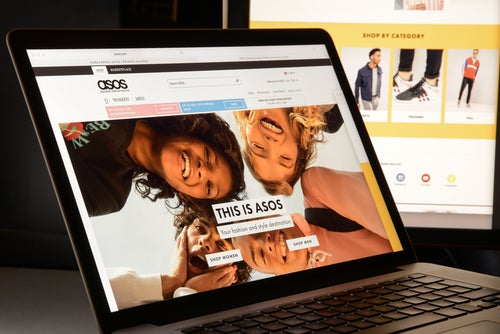
In its full-year outlook today, Asos, whose brands include Topshop and Miss Selfridge, reported a pre-tax loss of GBP31.9m (US$36m) from earnings of GBP177.1m a year earlier. Sales were up just 1% to GBP3.94bn.
Margins were down 180 basis points to 43.6% from 45.4% for the year ended 31 August. Despite this, shares in the retailer were up 9% in early morning trading to 534p as Asos announced a series of cost cutting measures and a GBP650m banking facility to give the retailer more “financial flexibility”.
CEO José Antonio Ramos Calamonte referred to the “incredibly challenging economic environment” in the company’s trading statement, adding: “Today, I have set out a clear change agenda to strengthen ASOS over the next 12 months and reorient our business towards the future. This includes a number of decisive, short-term operational measures to simplify the business, alongside steps to unlock longer-term sustainable growth by improving our speed to market, reinforcing our focus on fashion, strengthening our top team and leveraging data and digital developments to better engage customers.”
Calamonte, who was recently appointed chief executive, acknowledged the retailer had become “too complex and overstretched globally”, allowing costs to rise too much in its quest for growth, leaving its key international markets of the US, France and Germany lacking scale.
The CEO said Asos had also become increasingly reliant on discounting to attract customers, resulting in reduced newness for shoppers, which in turn has contributed to the erosion of gross margin in recent years.
“The implementation of the new commercial model and structure will enable Asos to operate a shorter buying cycle, enhancing speed to market and improving curation, and result in a change in stockholding requirements going forward,” Calamonte said.

US Tariffs are shifting - will you react or anticipate?
Don’t let policy changes catch you off guard. Stay proactive with real-time data and expert analysis.
By GlobalDataAsos announces new approach following loss
Following the completion of its commercial reorganisation this year, Asos said changes to its approach to merchandising and buying will be accelerated in support of a more competitive proposition and tighter stock cover.
This means the retailer will adopt a more flexible approach to stock that will mean less stock held in fulfilment centres to ensure more near-shore sourcing using a ‘Test and React’ model. A shorter buying cycle will also be implemented with “enhanced speed-to-market”, and a different approach to stock clearance will see the introduction of more off-site routes to clear product earlier in its lifecycle. This, Asos hopes, will reduce markdowns and increase the proportion of full-price sales.
“Progress against these changes will be evidenced by gross margin expansion, increased stock turn, faster speed to market and more effective capital deployment,” Asos said.
Despite these changes, the fashion retailer has issued a cautious outlook for the first half of its 2023 financial year, with an expectation of continued net losses, driven by the profit phasing and exacerbated by elevated markdown to clear stock.
“Against the backdrop of significant volatility in the macroeconomic environment, it is very difficult to predict consumer demand patterns for the upcoming year,” Asos said.
“Within the UK, Asos expects a decline in the apparel market over the next 12 months but remains confident in its ability to take share against that backdrop.
“Asos is fully focused on creating long-term sustainable growth, and is confident that these short-term operational measures, combined with a longer-term focus on creating a more digitally based organisation, with a more efficient operating model, a reinvented customer acquisition dynamic, and a global footprint that optimises capital allocation, will enable it to deliver on its strategic ambitions.”


